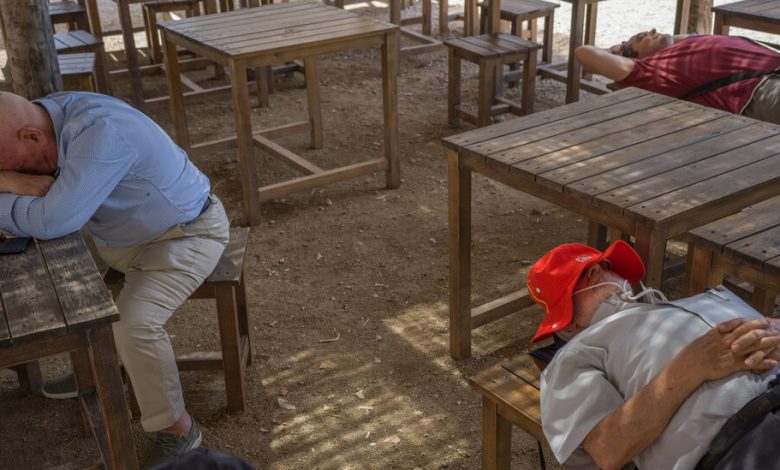What Do You Call a German Siesta? An Answer to the Europe Heat, Some Say.

A decade ago, in the wake of a financial crisis, Spain’s sacred siesta seemed to be under serious threat. Criticism was mounting across Europe that Spain’s sluggish economy resulted, in part, from its long midday break. Worried about being stereotyped as a sleepy, lazy country, Spain pledged to abolish the siesta to increase productivity.
The siesta lived on, though rumors of its demise circulated. And now, as Europe has been gripped by more frequent and longer heat waves, other countries have come to see the wisdom of the siesta, including Germany, where a strong work ethic is valued sometimes to the point of mockery.
German newspapers were among those sneering at the siesta during the economic crisis. But this summer, some German officials and work experts are extolling the virtues of a midday break.
“Siesta during the heat is certainly not a bad suggestion,” said Karl Lauterbach, Germany’s health minister, reacting to calls this week from top German public health officials to imitate Spain, where many cities still see shops close and streets empty between 2 and 4 p.m.
The heat — temperatures in Germany were around 90 degrees Fahrenheit this week — is forcing people to rethink their way of life and look to southern countries as examples of how to adapt to rising temperatures.
“We should follow the work practices of southern countries during heat,” Johannes Niessen, the chairman of Germany’s leading national association of doctors, said in an interview with the news outlet RND this week. “Getting up early, working productively in the morning, and taking a siesta at midday is a concept that we should adopt in the summer months.”
The origins of Spain’s famous siesta are a matter of debate. Some say that the practice originated in the country’s rural regions, with farmers taking a break to prevent overheating during the hottest hours of the day and returning to the fields when temperatures cooled. Another explanation is that the disjointed day emerged in post-Civil War Spain, when many people worked two jobs, one in the morning and the other in the late afternoon. The siesta has typified Spanish life for decades, although it is less common among many urban Spaniards today.
Still, on a recent afternoon in Granada, in southern Spain, many of the city’s shops were closed in the afternoon and locals were holed up in their homes, shutters drawn, as the cobbled streets boiled under temperatures exceeding 90 degrees.
It is a break many still hold dear. In 2015, the mayor of a village near Valencia issued an edict urging residents and visitors not to make noise during the siesta “to guarantee everybody’s rest and thus better deal with the rigors of the summer.”
But the siesta has also been the subject of intense ridicule and criticism, particularly after Spain struggled to recover from a devastating economic crisis in the 2010s.
Even in Spain, a pro-efficiency movement called the National Commission for the Rationalization of Spanish Schedules, which gained momentum after the crisis, contended that the country could become more productive if it adopted a more regular schedule. In 2016, the prime minister at the time, Mariano Rajoy, tried to reduce the time allowed for the siesta to bring the country more in line with the rest of Europe.
The long midday break has pushed dinner in Spain late into the evening, to 9 or 10 p.m., meaning Spaniards sometimes have supper when Germans are already in bed.
Siestas are used to chill, nap, recharge and have lunch. And now that Central and Northern Europe are facing the same extreme temperatures that Spain has been dealing with for years, the siesta seems like a good idea.
“People are not as efficient in strong heat as they are otherwise,” Mr. Niessen, the representative for German doctors, said.
Several research papers, including by the Massachusetts Institute of Technology, have found that napping improves productivity. The benefit of siesta has also been recognized for people’s health. Researchers at the University College of London showed in a study published last month that regular napping may help protect the brain’s health as it ages.
The team of researchers estimated that “the average difference in brain volume between people programmed to be habitual nappers and those who were not was equivalent to 2.6 to 6.5 years of aging.”
In recent years, trade unions in Germany and other Northern European countries have called to emulate the Spanish model.
Anja Piel, an executive board member of a trade union representing 6 million German workers, told German media this week that employers should close offices with temperatures of over 95 degrees. “Employers have to reduce the burden,” Ms. Piel said.
Catie Edmondson contributed reporting from Berlin and Juliette Guéron-Gabrielle from Paris.
